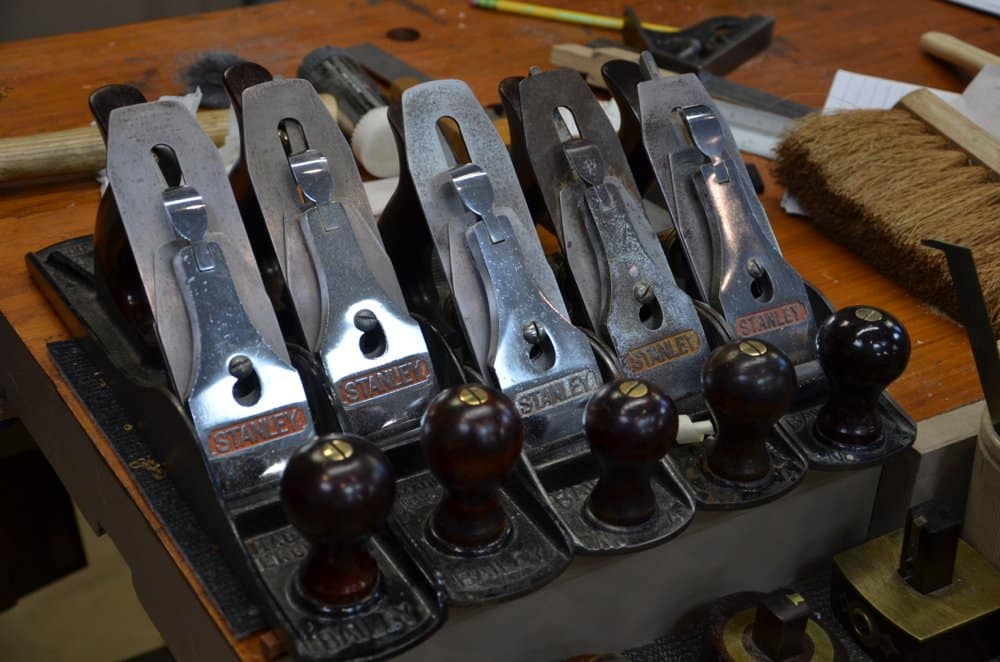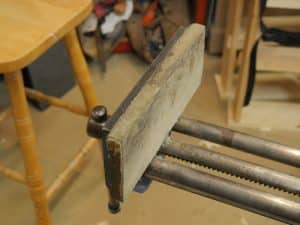Closing Out On My Bench Fitments
To perhaps close out my workbench series on the bench I currently use I thought you might want some close ups of some things I particularly think makes my work easier. Many of you tell me that you want the inside jaw of your vise flush with the face edge of the bench and that seems fine to me, but I have never found a single advantage to this whereas there are several advantages to having the vise a step forward go the edge. 
Notice the swivelling retainers. The lighter saws benefit from this and stop the saws from lifting of the wrapped screws. I don’t want hooks as such because of the lift and pull action. I want something that slips on and off and this works for me. The 14” brass backed saw is much heavier and never falls off through bounce from banging.




I keep my most used planes on my benchtop on the far opposite corner from my main working vise. Here they line up well. Two jacks, and the remainder are smoothers with different setting depths or a simple scrub plane.
Next to these I like a few daily use gauges of different types. I have one slitting gauge, three combination or mortise gauges and then i have common marking gauges.
The old jam jar holds different pencils, rules, sticks, felt tip pens and so on. Next to that is a tin can filled with glue sticks. When I demo hand sawing I often cut several cuts next to one another and then I cut them to length and have 30 glue sticks ready to go as needed.
Around the vise
The risk of damaging furniture by using a tape clipped to a belt is too high so we furniture makers generally don’t carry them as a carpenter might. I usually take the clip off and screw it to my bench and use it for a shop rag holder when filming.
One of my better ideas is the insertion of hardwood blocks and chamfering out a recess to the corner. The recess gives me much more cutting depth with the tenon saw and i rarely ever catch it.
The leather in one jaw of the vise works well to increase grip without over tightening or the need for too much cinching on the vise to hold the work.







Hi Paul,
Superb blogs on your bench and working space. Thank you for sharing.
Paul,
I think I have the best of both worlds re: vise set off vs. flush mount. My bench has a flush “English” style apron to the right of the vise, the left side is off set about 45mm. It works very well for my way of working.
Tail vises; what a waste of time, effort, and bench real estate. Had ’em and never used ’em. Left the tail vise off this bench and never missed it.
Thanks for all your work,
ken hatch
Hi Paul,
I notice you store your chisels in the open tool bin without any covers for the edges. Do you not get then chipped and dulled by putting them in like that?
No, never. In fact I have stowed my chisels in similar fashion in tills for 50 years to date and cannot recall one damaged chisel. And….did you know more people cut themselves by putting the guard tips on chisels than actually using the chisels. I usually advise my students to first discard chisel guards after they arrive. They’re impractical and unnecessary really.
Paul what is you opinion of front vise vs the Record style quick release? Are there distinct advantages of one over the other? Thanks.
I see where Record sold it’s tooling to an Indian company. The vise is now marketed through Woodcraft as the Eclipse EWWQR10-NA; got very high ratings on Amazon.
James,
I have had an eclipse for a year. I works great so far. The quick release sticks a little at first, but after some use it works smooth. I used plywood for the jaws for a quick fix, but never changed it out as it has worked fine for me.
If you pick a decent grade of plywood for jaws they will indeed hold up and actually I have found the plywood works better than solid wood for a few reasons not the least of which is it stays flat and resists distortion.Buffalo Board is an exterior grade WBO (weather and boil proof) Phenolic Ext Birch Plywood with a slip-resistant cross diagonal pattern. It was developed for truck and van beds and floors and decking of different types, safety ramps, access platforms, walkways, stages. grandstands and play equipment. Buffalo Board is manufactured in Europe from 1.4mm birch veneers and bonded with a tough, thermosetting phenolic resin which conforms to EN314-2: Class 3 for bonding (equivalent to the old WBP) and also meets EN13986. Tough stuff. Here in the UK an 8 x 4 18mm (3/4″) sheet costs about £45. Try finding a van lining form and seeing of you can get an off-cut from them.
Also, on bench vises and durability. The York vise from Czech Republic had had some issues with the quick release block fracturing and though willing to trade out the block they seem unwilling to actually correct the flaw. We had to replace several blocks two years ago, I think 8 of our 20 vises. I am afraid part time use of vises might be several years for most people and some companies rely on this. A year’s use for most woodworkers is about two weeks for me. An old, not new, Record vise should go for about 100 years of six-day-a-week use. That’s why, because of my blogging on them and proven use of them, the price keeps going up on the eBay prices. Buy em while you can. £200 is not too much to pay for a lifetime vise.
Paul you didn’t mention anything about a “front vise”. Any pros or cons about them?
I’m sure they are fine. Everyone develops dexterity in accord with the equipment they use. With any long term exposure to particular equipment everyone gets used to what they work with. I don’t think I would change now to another vise but it’s nothing more than the guaranteed efficacy I have found in my Record and Woden vises.
Hi Paul. I’ve very much enjoyed this series on your workspace organisation. However, I’ve never seen you using a bench hook, and there are non in evidence within this description of what you keep where. Do you use a bench hook at all, and if so where do you keep it? In my secondary school woodworking class there was a sloping bin at each end to the bench, with bench hook stored in it. Of course, we worked one student to each side of the bench, with the well in the centre shared.
No, I never use a bench hook because when I was an apprentice no one ever used them there either. We only used them in school to my recollection. We have them at the school and very occasionally someone, one in a hundred, will ask for one. I suppose if I think about it they really more irritate me because usually they are more in the way than useful to me. But, you know, that’s just me.
One use I’ve found for the tail vise is when planning a longish board that I have in the front vise, I put a support piece in the tail vise and snug it up under the piece being planed.
I love my Paul sellers bench or as my dad would say a small version of the one he used for 50 year as an amateur cabinet maker. It’s exactly the same as my his dad used as a pro for over 75 years! The one extra thing I put on mine is a leather tape measure recessed glued and covered with clear resin I find it really helps me stay in line. Thanks guys it made my dad really happy to see me using “the small bench” ha ha thanks guys keep it coming
rubber sheeting used around kitchen cabinets as baseboard makes a fine grip or cushion for my vise. I attached a sheet, cut to size, to the outer jaw of my moxon vise with doublesided automotive tape .
Someone told me – Laminate glued on the jaws of the vice is very nice for better grip. What do you think about it?
Have a nice day